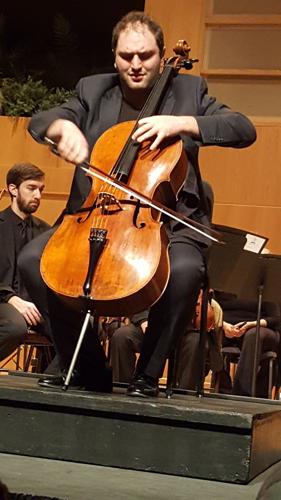British conductor Jessica Cottis stood off to the side of the stage at St. Andrew’s Presbyterian Church Friday night as Tucson Symphony Orchestra stage manager Stacey Hubert and orchestra manager Benjamin Nesbit arranged nearly three dozen chairs and music stands.
The orchestra would double in size from its opening number to the Shostakovich Cello Concerto with guest Julian Schwarz. And it would shrink back down for the concert-ending performance of Mozart’s 29th Symphony.
Cottis filled the downtime with chit-chat about the Shostakovich and a little about Mozart, but there came a moment when the action on the stage seemed far more interesting to Cottis than her own words.
It kinda reminded her of a soccer match, she said, the way the stage crew was moving the chairs around and positioning the music stands to accommodate a larger ensemble than the one she led for the concert opening performance of British composer Thomas Adés’ “Three Studeis from Couperin.”
Just wait for the Mozart, she told the audience, which filled about a third of the Oro Valley church. They would have to replay the musical chairs to create an even smaller space; only two dozen musicians were needed for the composer’s bright and playful symphony.
Of course the stage makeover was a just a minor distraction from the music. And what terrific music Cottis made with the TSO and Schwarz. From that opening Adés work to Cottis’s spirited take on the Mozart, Friday’s concert was a great way to kick off 2018.
Here are three things that impressed us about Cottis’ debut:
- Let’s hear it for the Brit: Cottis, an in-demand conductor in Europe and her native Australia, made her official American debut with Friday night’s TSO concert. If there were any American classical music talent managers in the audience, we’re fairly confident her Tucson concerts will be the first of many U.S. podium appearances. The 38-year-old turned in a spirited performance: Expressive and energetic, she had the symphony rocking to Mozart’s playful and exuberant Symphony 29. She brought out Mozart’s wonderful colors and emotions and accentuated the composer’s spirit with so much enthusiasm you couldn’t help but get lost in her performance. She also introduced us to one of her adopted home’s celebrated composers, Brit Adés, whose “Three Studies from Couperin” is the second reason we want to see this concert again.
- Meeting the 17th century in the 21st: This was the first time we have heard from Adés, whose “Three Studies” is a marvelous reimagining of a trio of the Baroque composer’s works. But more than a reimagining, Adés reinvented the work, infusing the original works beat for beat with enough modern sensibilities and flourishes to make it wholly original. A little pizzicato from the strings, a quiet and quick bang on the percussion, cellos and violas teaming up to play what sounded like three-quarter notes masking as common scales. At one point in the third song, Couperin’s “L’âme en peine,” quick bursts from the timpani interrupted sweeping string passages. Strings sounded as if they were playing out of time, some pizzicato while others were lightly bowed, and if you weren’t paying close attention or came in the St. Andrew’s hall midstream, you would have thought nothing you heard made sense. But when Cottis brought it all together, the effect was sublime, and beneath the subtle dissonance, Couperin’s original Baroque sound shined.
- Where did this guy come from?: When he came on stage, all dressed in black, guest cellist Julian Schwarz had the nervous giddiness of someone who was throwing caution to the wind. We didn’t know what to expect, and sometimes that’s the best surprise of all. Because when Schwarz, son of Seattle Symphony conductor Gerard Schwarz, started playing, Friday’s audience was simply blown away. It’s no surprise that Schwarz would have the technical chops for the Shostakovich Concerto; the 26-year-old has been performing before audiences since he was 11. But we weren’t expecting him to have so much stage personality. From his facial expressions — ranging from tortured rock guitarist angst to frat boy prankster to his playful asides — at one point he turned to the audience and mouthed “ba dump bump bump” with a big smile on his face to mimic what the orchestra was playing — you could tell Schwarz was having so much fun. After he finished the 30-minute Shostakovich workout, he returned to the stage and recounted a master class he had led at the University of Arizona earlier Friday. The students had mentioned Bach, which got him thinking about Bach. And then Cottis made a suggestion: “As if that wasn’t enough work, the maestro mentioned, ‘Why don’t you play something’,” he said, then gave us five more minutes of his time playing the famous prelude to Bach’s wonderful Cello Suite. Talk about sweet endings.





